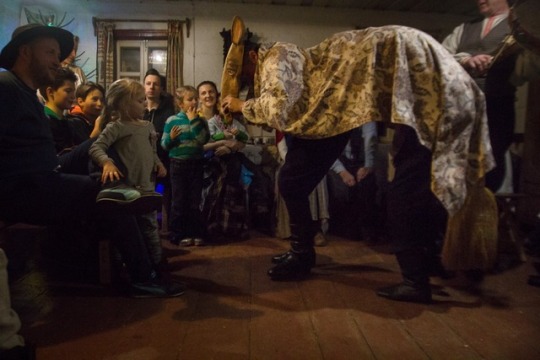#Schedry vecher
Explore tagged Tumblr posts
Photo







Villagers in Polesia region, Belarus celebrate Shchedry Vecher (Generous Eve), the Orthodox New Years Eve which has remnants of the ancient pre-Christian Slavic festival of Kolyada.
Kolyada or koleda (сyrillic: коляда, коледа, колада, коледе) is an ancient pre-Christian winter festival. It was later incorporated into Christmas. The word is still used in modern Ukrainian (Коляда, Kolyadá), Belarusian (Каляда, Kalada, Kalyada), Russian (Коляда, Kolyada), Polish (Szczodre Gody kolęda), Bulgarian, Macedonian, Serbian (Коледа, Коледе) Lithuanian (Kalėdos, Kalėda) and Bosnian, Croatian, Czech, Slovak, Slovene (koleda). The word used in Old Church Slavonic language (Колѧда) sounds closest to the current Polish language pronunciation, as Polish is the only Slavic language which retains the nasal vowels of the Proto-Slavic language. One theory states that Kolyada is the name of a cycle of winter rituals stemming from the ancient calendae. Some claim it was named after Kolyada, the Slavic God of winter or Kolyada, the goddess who brings up a new sun every day.
In modern Ukrainian, Russian (kolyada), Czech, Slovak, Croatian (koleda), Kashubian kòlãda, Romanian (colindă) and Polish (kolęda, Old Polish kolenda) the meaning has shifted from Christmas itself to denoting the tradition of strolling, singing, and having fun on Christmas Eve, same in the Balkan Slavs. It specifically applies to children and teens who walk house to house greeting people, singing and sifting grain that denotes the best wishes and receiving candy and small money in return. The action is called kolyadovannya in Ukrainian and is now applied to similar Old East Slavic celebrations of other old significant holidays, such as Generous Eve (Belarusian: Шчодры вечар, Щедрий вечiр) the evening before New Year's Day, as well as the celebration of the arrival of spring. Similarly in Bulgaria and Macedonia, in the tradition of koleduvane (коледуване) or koledarenje (коледарење) around Christmas, groups of kids visiting houses, singing carols and receiving a gift at parting. The kids are called 'koledari' or rarely 'kolezhdani' who sing kolyadka (songs).
Koleda is also celebrated across northern Greece by the Slavic speakers of Greek Macedonia, in areas from Florina to Thessaloniki, where it is called Koleda (Κόλιντα, Κόλιαντα) or Koleda Babo (Κόλιντα Μπάμπω) which means «Koleda Grandmother» in Slavic. It is celebrated before Christmas by gathering in the village square and lighting a bonfire, followed by local Macedonian music and dancing.
Croatian composer Jakov Gotovac wrote in 1925 the composition «Koleda», which he called a «folk rite in five parts», for male choir and small orchestra (3 clarinets, 2 bassoons, timpani and drum). There is also a dance from Dubrovnik called «The Dubrovnik Koleda».
The ancient God of the underworld Veles was known to regularly send spirits of the dead into the living world as his heralds. Festivals in his honour were held near the end of the year, in Winter, when time was coming to the very end of world order, chaos was growing stronger, the borders between worlds of living and dead were fading, and ancestral spirits would return amongst the living. This ancient celebration of Velja noć (Great Night) still persists in folk customs of Koleda, which can happen anywhere from Christmas up to end of February.
In pre-Christian Croatia, «koleda» was a celebration of death and rebirth at the end of December in honour of the sun and god - Dažbog, whose power once more begins to increase in those days. Krijes, meaning bonfire in Croatian, is another festival honouring the sun, during the summer at the time of his greatest strength; a celebration for good harvest.
Source: http://www.rodnovery.ru/en/articles/868-kolyada
325 notes
·
View notes
Photo





Happy Malanka, Eastern Europe! As you’ll recall, certain parts of the world did not adopt the Gregorian Calendar until scandalously recently, and for those who have retained some of the Julian Calendar (Old Style) dating in their folk traditions, today would have been New Year’s Eve, or Generous Eve, aka, Malanka, aka, Melania’s Day (after Saint Melania the Younger). So it looks like we can give Starting 2018 Right another try!
Stamp details: Stamp on top, left and middle second row: Issued on: December 12, 2006 From: Chișinău, Moldova MC #570-572
Right second row and bottom stamp: Issued on: December 3, 2011 From: Chișinău, Moldova MC #777-778
#Маланка#Malanka#malanca#Шчодры вечар#Маланья#Schedry vecher#january 13#new year's eve#stamps#philately#moldova#Melania the Younger#Saint Melania the Younger#Saint Melania#Melania's Day#Меланія Молодша#Преподобна Меланія#Меланія#sărbători de iarnă#Mihail Statnîi#Valerii Metleaev#rostogolirea roții arzînde în ajun de crăciun#elena bontea
10 notes
·
View notes